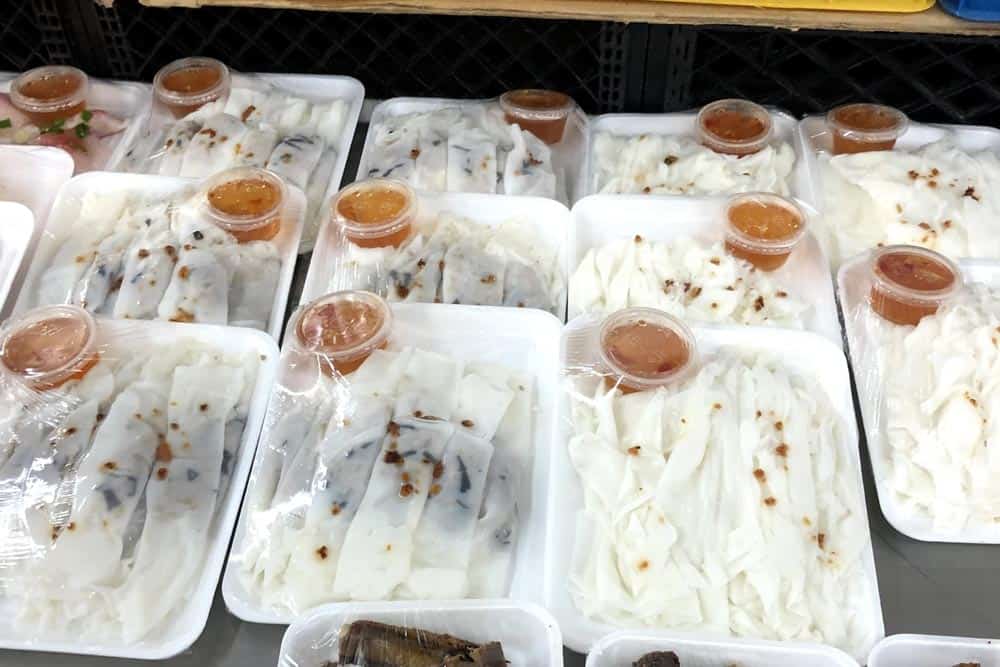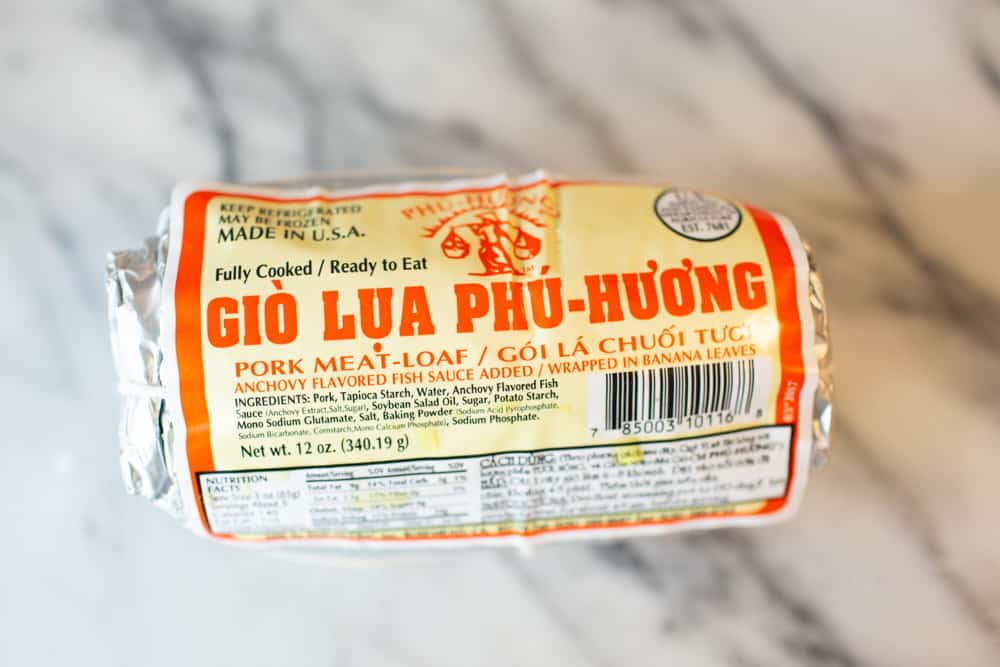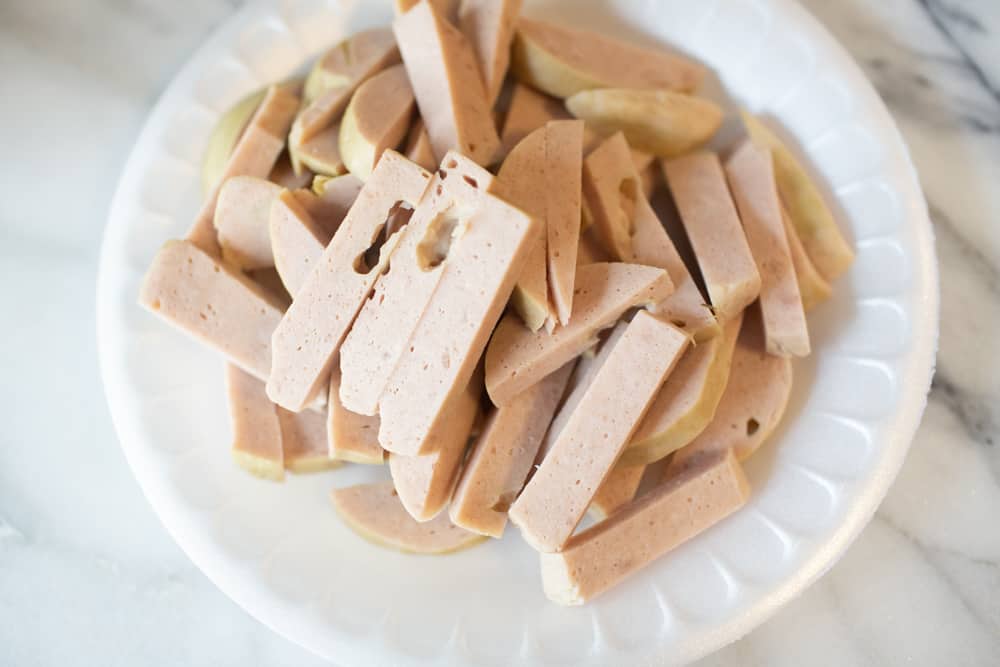
While it does take a little skill to master the craft of making these noodle sheets that are the foundation of the stuffed rice cake, the technique is a skill that you can quickly master right at home.
I’m going to share with you in this post some of the tips and tricks on making this dish a success the first time. First, I’m going to guide you through all the steps for making your first rice crepes.

Next, I’m going to take you from making the delicious filling all the way to how to serve it on a delicious bed of fresh herbs and vegetables. Banh cuon is a tasty, savory, and wonderfully delightful that you will absolutely love making.
What is Banh Cuon?
Banh cuon is a dish made with Vietnamese steamed rice rolls, which are thin sheets of steamed rice batter that is stuffed and rolled with minced pork, wood ear mushrooms, and sometimes jicama as it’s filling. It is generally served accompanied with bean sprouts, chopped lettuce, sliced cucumber, fresh basil and mint, fried shallots and onions, Vietnamese sausage pork roll (Cha Gio) and finally drizzled with Vietnamese sweet and sour fish sauce dressing sauce – Nuoc Mam.

These dishes are popular in the streets of Vietnam because These delicious rolled crepes are soft, served with a ton of fresh garnishes as well as cold fish sauce, which makes it a refreshing dish or snack anytime.
Visitors to Vietnam and Vietnamese restaurants seek out this banh cuon because it expresses cultural elements of the Vietnamese region through of its ingredients makeup. There is a beautiful marriage of yin and yang between its ingredients.
For me, I love it because I feel like it is a really light dish that I can just have three bowls and still feel light!
What’s the history on Banh Cuon?
Banh cuon is an ancient dish and comes from North Vietnam. It is steamed rice rolls, filled or unfilled, what determines the name of the dish. Banh cuon (‘cuon’ = roll) refers to what westerners like to relate it to as stuffed rice ravioli and banh uot (‘uot’ = wet) refers to non-filled rice noodles. However, both references are never used interchangeably and there are more variations of rice ravioli with different fillings and toppings, largely dependent on the region. Banh cuon is the filled version whereas banh uot is the unfilled crepe version.
Both dishes are garnished with delicious fresh herbs, Vietnamese pork sausage (cha lua) and a dressing of sweet and sour fish dipping sauce. Banh cuon is lightly filled with a mixture of ground pork and wood ear. This dish is eaten as an appetizer or as a snack. Today, Asian groceries, and specialty stores also have fresh rice sheets that can be cut to the desired size and shape, but it is better to make it fresh!
Is Banh Cuon a crepe?
Banh cuon can be seen as both a crepe and a steamed rice roll.
I prefer referencing it as a crepe because the outer layer is a moist, yet super thin rice cake. The reason why some people may not refer to it as a crepe is because the cake doesn’t lay flat, similar to an omelette. Rather, it’s usually filled and rolled.
What are some other names for Banh Cuon?
Other monikers for banh cuon are:
Banh Cuon
Banh Cuon Chay
Banh Cuon Nong
Vietnamese Steamed Rice Rolls
Vietnamese Steamed Rice Cakes
Vietnamese Stuffed Pancake
Rolled Rice Pancake
Wet Rolled Rice Noodles
By breaking down the translation, you’ll have a better understanding of WHY this dish has so many names. Below are each of the words in the various naming conventions and what they mean:
banh – means snack
uot – means wet
cuon – means rolled
chay – vegetarian
nong – means grilled
Banh Cuon means rolled snack. In general, the word cuon means rolled, including a Vietnamese spring rolls which are called goi cuon.
Banh Cuon Chay – This is the vegetarian version where you do not include the minced pork in the recipe.
Banh Cuon Nong – This is the same general banh cuon recipe, but includes grilled meat on top.
What’s the difference between Banh Uot versus Banh Cuon?
Banh cuon and banh uot are often confused with each other because the dishes are made with the same crepe mixture. Banh uot refers to the non-stuffed version while banh cuon refers to the crepes rolled with minced pork and wood ear.
Banh uot translates to wet cakes. Banh cuon translates to rolled cakes because it has fillings that’s why they roll it. Banh uot has absolutely no filling whatsoever, so it’s more flexible and and softer with no filling which is why it was merited the name wet cakes.
The image below shows the difference between banh cuon (left) and banh uot (right). The one on the left that has the darker middle is filled with minced meat and wood ear mushroom, which is banh cuon. The one one right is banh uot, which is not filled with anything (a great vegetarian option).

Banh cuon and banh xeo are two very popular Vietnamese dishes. The difference is that banh cuon is made with rolled rice noodles whereas banh xeo is made with a batter that has rice flour, turmeric and coconut cream. Banh cuon’s filling is typically made with minced pork whereas banh xeo includes filling of pork belly, bean sprouts and shrimps inside that makes it look like an omlette.
This is banh cuon:

This is banh xeo:

You pronounce Banh as in “bawn” and cuon is pronounced “kwoon”.
Is Banh Cuon gluten-free and vegan?
If you leave out the ground pork, this recipe can be made to be gluten-free and vegan. It can be customized without impacting the essence of the recipe to be gluten-free and vegan.
Finding Ingredients for Banh Cuon at the Asian Supermarket
As always, I prepare a list of the specific ingredients that you won’t find in traditional grocery stores. You’ll definitely want to make a separate trip to the Asian market to grab these ingredients:
Rice Flour
This is the brand I generally buy for rice flour.

You will find this in the same aisle as the rice flour.
Asian Shallots
Asian shallots are generally smaller and uniform in size. If you go to your local grocer that is a non-Asian market, they may be bigger than your average asian shallots you find at an Asian market.
Dried Wood Ear Mushrooms
Wood ear mushrooms come in a package where it literally looks like big elephant ears that are dehyrdrated.
Thai Basil
Thai basil is not the same as regular basil that you find in a regular grocer. Thai basil has a different tone and flavor to it.
Vietnamese Mint
Fried Shallots
These generally come in a jar and will pretty much last you the entire year.
Pork MeatLoaf (known on packaging as Cha Lua or Gio Lua)
This can be found in the frozen section of your local asian grocer. They normally are either wrapped in banana leaves or aluminum foil. There are also flavored varieties, some that include A LOT of black peppercorn. I generally choose the non-peppercorn version.
If you wanted to cheat the batter, you can always buy the batter premade.

Here’s what it looks like when the pork meatloaf is sliced:

Banh cuon does require a little artisanship, but I’m sure that with a few tries, you will be able to master this delicious steamed rolled rice cake crepe mastering.
Just know that the first time you make it, it will NEVER turn out right. It is pretty easy to master AFTER trying a few times.
I know when I first started making them, often I cooked it to long so it made the rice cake way too thick. Even when it doesn’t come out perfect, know that it will still taste just as delicious.
After you master the rice flour, if you wanted to level up your banh cuon recipe, you can add grilled pork or roasted pork belly on top for more protein.
Ingredients to Make Authentic Vietnamese Banh Cuon at Home
Ingredients for Banh Cuon Batter
- 1 1/2 cups of rice flour
- 1/2 cup of tapioca flour
- 1/2 teaspoon salt
- 2 1/2 cups cold water
- 1/2 cup of vegetable oil
- For the Filling:
- 1 pound of ground pork
- 4 cloves of garlic, minced
- 4 red Asian shallots, diced
- 3 pieces of dried wood ear mushrooms, reconstituted in hot water, chopped
- 1 small white onion, diced
- Salt and pepper, to taste
- For the Accompaniments:
- 1/2 cup of fried shallots
- 1 medium cucumber, sliced
- 1 bunch of Thai basil, leaves plucked
- 1 bunch of Vietnamese mint, leaves plucked
- 10 ounces of mung bean srouts, rinsed
- nuoc mam (recipe here)
Instructions on How to Make Banh Cuon
- Make the batter mixture. To make the batter, combine rice flour, tapioca flour and salt with the cold water. Whisk until the flour dissolves and forms a smooth batter and it’s completely combined. Let the batter sit for at least 30 minutes (you can also prep it overnight).
- Soak the Wood Ear Mushrooms. Put the mushrooms in a bowl, cover with water and soak for 20 minutes, then drain and thinly slice.
- Make the Pork Filling. In a sauté pan, add just enough olive oil to coat the bottom. When hot, add in the diced white onion and sauté until fragrant. Season with salt and allow the onions to get translucent. Fry the garlic and shallots until fragrant, then add the pork, mushrooms, salt and pepper to taste.Stir-fry for 4 minutes, then transfer to a bowl and set aside.

Steam the Batter. In a sauté pan, add a drizzle of oil to coat the pan and heat over medium-high.I like to use an oil brush or a silicon brush to make sure that the pan is evenly coated for a level distribution of oil.


Once you lift the lid, the noodle should be wet, opaque and almost see through. Set the pan aside on a burner to cool until you make the next batch. If you’re working with a partner, you can keep on cranking out the sheets.





What do you eat with Banh Cuon?
Since the dish has a lot of accompaniments like bean sprout, cucumber, fresh herbs, and pork rolls, you really don’t need anything else. If you wanted to level up your banh cuon recipe, you could add in grilled pork as a side dish or even as a topper. You’ll want to drizzle nuoc mam over top or dip the piece you want into the nuoc mam before eating.

Banh cuon’s deliciousness cannot be compared to any other dish. It is absolutely divine, and you’ll have to try it for yourself because I can’t do the dish the justice that it deserves in words.
It’s a delicate dish that is moist with a satisfying and fresh taste with all of its accompaniments.
If you love this Vietnamese steamed rice sheet recipe (banh cuon) as much as our family does, please write a five star review and help me share on Facebook and Pinterest!


This recipe and image sources are referred in website: Cookingwithlane.com. Thanks so much!
 Asian Recipes
Asian Recipes



















No comments :
Speak Your Mind: